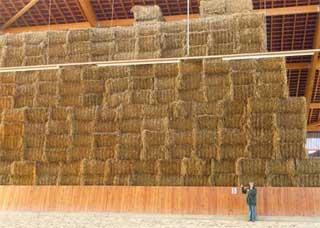Biofuels from Cereal Straw
Published on 29 January 2014 in Climate, water and energy

Introduction
Sustainably produced second generation bio-fuels (and associated co-products) from cereal straw could lead to reduced greenhouse gas (GHG) emissions, contribute to national energy security and lead to growth and jobs, particularly in the agricultural and renewable energies sector.
However there are numerous scientific, economic and infrastructure challenges associated with the generation of biofuels from this form of biomass, many of which remain to be solved.
ClimatexChange (CxC), Scotland’s centre of expertise on climate change, associated with BBSRC Sustainable BioEnergy Centre (BSBEC) has explored how to overcome the challenges by:
- modifying the feedstock (cereal straw) to make it more amenable to deconstruction
- investigating how to improve the efficiency of deconstruction processes
- discovering new micro-organisms that are tolerant to inhibitors released during the deconstruction process while improving alcohol yield during fermentation.
The RESAS-funded CxC research focussed on addressing the first of these challenges. The bulk of cereal straw is composed of ligno-cellulosic material that is recalcitrant to deconstruction. We are exploring how to modify barley straw to make it more suited to the extraction of fermentable sugars for the production of fuel without affecting the yield or composition of the grain, which is crucially important to the hugely successful and iconic Scottish whisky industry.
Key Points
- Natural variation for sugar yield from barley straw exists and could be exploited by breeding to optimise straw as a feedstock for biofuel production.
- Inducing variation in genes from the lignin biosynthetic pathway alters lignin content and/or composition and can lead to improved sugar yield.
- Improving straw processability does not appear to be linked to crop performance in terms of yield or environmental resilience.
- UK farmers are open to providing excess straw for bio-refining processes given a worthwhile return for their investment.
- There is sufficient current surplus to generate c. 1 billion litres of bioethanol from straw.
- The infrastructure for biofuel production needs to be developed.
Research Undertaken
A flagship experiment of the Cell Wall Lignin project was a genetic study aimed at identifying variants of genes (called alleles) that improve sugar yields from barley straw. This experiment was extremely successful: we ranked 850 elite spring barley varieties according to the amount of sugar that can be released from their straw (that is, their phenotype). We also found little correlation between sugar yield and either grain yield or the physical characteristics of the stem. This means that we should be able to breed for straw sugar yield without impacting deleteriously on yield or straw strength.
We then combined this phenotypic information with genotypic data which allowed us to reveal regions on the barley genome that are associated with each of the traits. Rigorous experimental design and analysis ensured that only genuine effects were revealed. We observed that 6-9 locations (depending on significance cut-off) across the seven barley chromosomes were significantly associated with sugar yield. Two correspond to regions where clusters of lignin biosynthesis genes are found. We have suppressed these using modern molecular biological approaches and several exhibit reduced cell wall lignin content/composition and improved sugar yield. We aim to build on these significant advances.
BSBEC’s Dr Paul Wilson (Nottingham University) investigated the sustainability of using UK straw for fuel and quantified the costs and benefits in financial, environmental and energy terms. He found great willingness to supply straw, and allowing for requirements to replenish the soil, for fodder and forage, farmers (in England) would supply excess cereal straw for bio-refining given a minimum price of £50/t at today’s prices for baled straw at the farm gate. Across the UK this could potentially produce approximately one billion litres of bioethanol. Thus, although the infrastructure for biofuel production is still in its infancy, it now at least has the potential to flourish.
Policy Implications
This project has several implications for many national policies.
- Renewable transport fuels: The research described is directly relevant to the aims of the UK Renewable Transport Fuels Obligation (RTFO) and the EU Renewable Energy Directive. The RTFO recently reported that in the year to April 2014, 425 million litres of renewable fuel have been supplied (3% of the road total). The potential to generate 1 billion litres of bioethanol from cereal straw is therefore highly significant.
- Greenhouse gases: Biofuels positive carbon balance addresses the aims of Low Carbon Scotland - Meeting our Emissions Reduction Targets 2013-2027 which in turn addresses the Climate Change (Scotland) Act 2009. The latter sets a target of at least 42% emissions reduction by 2020 (UK target is 34%). Exploiting this research would help achieve this target.
- Food: We “support the growth of our food and drink industry” and ensure continuation of “secure and resilient food systems”, tenets of the Scottish Food and Drink policy by focusing research on cereal straw in order to not compromise the food and drink use of the cereal grain.
Author
Professor Robbie Waugh, James Hutton Institute robbie.waugh@hutton.ac.uk







